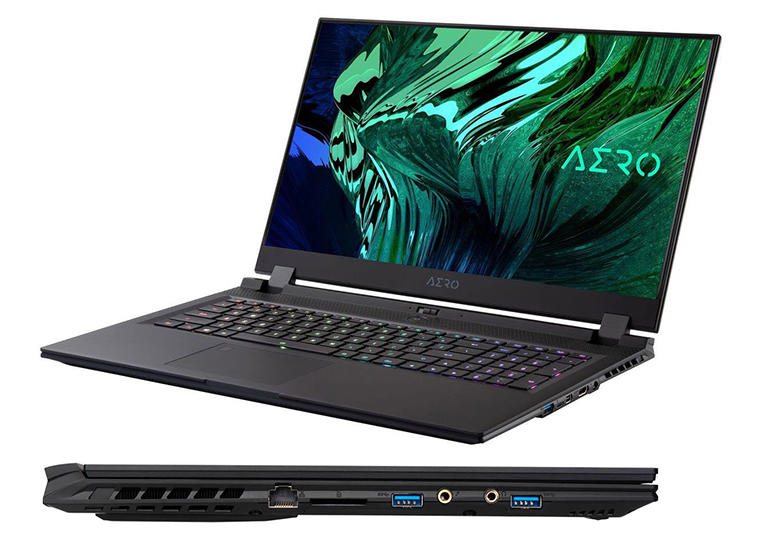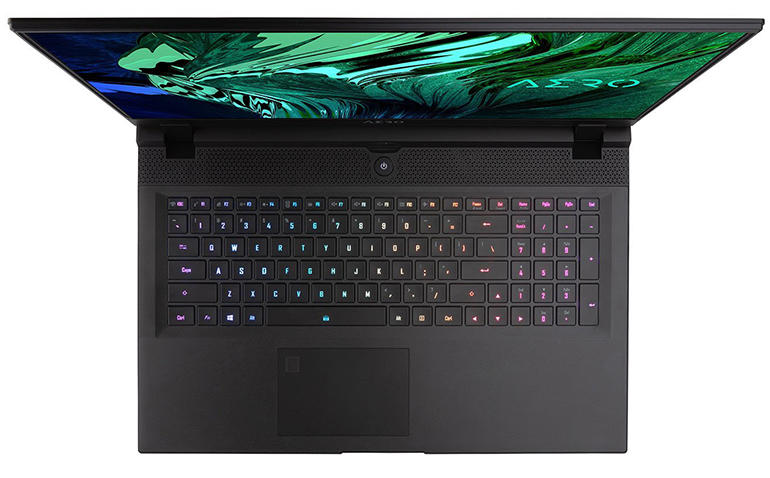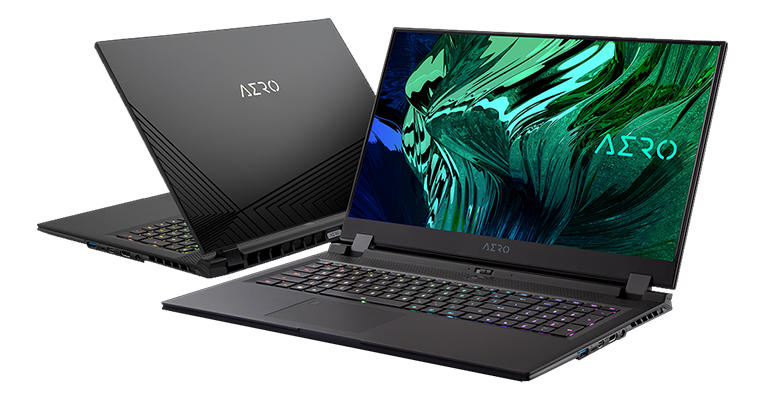Gigabyte is best known for its Aorus gaming PCs and displays, but it also produces the Aero range of laptops for creative users. Needless to say, Gigabyte’s experience with high-end graphics ensures that the Aero laptops deliver impressive performance. However, they also exploit the company’s experience of engineering and cooling systems to squeeze that high-end performance into attractive, slimline designs that remain impressively cool and quiet even when running demanding graphics software.
Features & design
The Aero laptops are available with either 15-inch or 17-inch displays, and both FHD and 4K resolutions, but we tested the top-of-the-range Aero 17 HDR XC, which has a 17.3-inch IPS screen with 4K resolution (3840 x 2160 pixels, 254.5dpi). Despite the large screen and high-end specification, Gigabyte has managed to keep this laptop down to just 21.4mm at its thickest point. The company quotes a weight of approximately 2.5kg for the Aero’s aluminium casing, although our review unit came in at closer to 3kg. Even so, that shouldn’t be a deal-breaker for a desktop replacement system which is likely to spend most of its time indoors.
The 4K display is admirably bright and sharp, and supports HDR 400 to provide rich, vivid colours. It did sometimes look a little over-saturated to my eye, mainly on skin tones when streaming video, but Gigabyte states that it supports 100% of the Adobe RGB colour gamut, so it will be suitable for a wide range of graphics and design tasks. It’s a shame, though, that there’s no mention of the DCI-P3 standard, which is widely used for professional video editing, as this laptop’s performance makes it well suited to high-end video work too.

The Aero 17 HDR XC is powered by a 10th-generation Core i7 processor with 32GB of RAM, a 1TB SSD and graphics courtesy of Nvidia’s GeForce RTX 3070 with 8GB of video memory. The 17.3-inch screen is a 4K IPS panel. There are USB 3.2 ports, one Thunderbolt 3 USB-C port, HDMI 2.1 and mini-DisplayPort 1.4 connectors, 3.5mm audio in and out jacks, an SD card reader, a power input and an RJ-45 Ethernet port.
Images: Gigabyte
The build quality of the Aero 17 HDR XC is also impressive. The 3mm bezel surrounding the glass panel helps to keep your focus on the high-quality display, but the panel remains nice and firm, with just enough flex to help it cope with the occasional bump when it’s on the move. There are large cooling vents on the back, and on both sides of the laptop, but Gigabyte’s ‘WindForce’ cooling system, which consists of two, 71-blade fans, merely produced a low, gentle hum even when the Aero was repeatedly looping through demanding Unigine Valley graphics tests.
That solid design means that the keyboard feels very comfortable. It’s a full-size unit, with numeric keypad, and the firm keys actually feel like they’re pushing back when you press on them. The laptop’s matte-black design isn’t particularly eye-catching, but the Aero borrows a few tricks from its gaming stablemates, with the Fn+Space key combo providing some multi-coloured eye-candy from the keyboard backlight.
The Aero 17 HDR XC is well connected too: the display may not support DCI-P3, but HDMI, mini-DisplayPort and Thunderbolt 3 ports provide multiple options for connecting an external monitor. There are also three USB 3.2 ports, a slot for an SD memory card, 3.5mm audio jacks for microphone and headphones, plus the latest Wi-Fi 6 (802.11ax) and Gigabit Ethernet for wireless and wired networking respectively.


Gigabyte’s Fusion RGB Per-Key Backlit Keyboard has a firm action, and can do some fancy back-lighting effects.
Image: Gigabyte
Price & options
Top ZDNET Reviews
Gigabyte doesn’t make it easy to buy its products. The company’s website lists a somewhat confusing range of configurations and options for the Aero laptops including, as mentioned, 15-inch and 17-inch models with either FHD or 4K resolution. Last year’s ‘XB’ models are also still available with 9th generation Intel processors, while this year’s ‘XC’ models move up to 10th generation processors, as well as a variety of Nvidia GPU options. However, you can’t buy direct from Gigabyte in the UK, while its online store for the US offers a very limited range, so you’ll need to shop around for the specification you need from the company’s third-party distributors.
We tested the Aero 17 HDR XC, which costs £2,249.17 (ex. VAT; £2,699 inc. VAT) or $2,609 with an 8-core Core i7-10870H processor running at 2.2GHz (up to 5GHz with TurboBoost), along with 32GB of RAM and a 1TB SSD. That price also includes an Nvdia GeForce RTX 3070 graphics card with 8GB of dedicated video memory. Gigabyte states that Core i9 processors and GeForce RTX 3080 upgrades are also available, although we hadn’t found those online at the time of writing.
Performance
The Aero 17 HDR XC provides heavyweight performance for graphics and design work. Its Core i7 processor recorded Geekbench 5 CPU scores of 1300 (single core) and 7600 (multi core), which put it alongside similar 17-inch workstation-class laptops such as Dell’s Precision 5750. But it’s the GeForce RTX 3070 GPU that really stands out: the Aero achieved a score of 150fps when running the Cinebench R15 graphics test, but on the more demanding Unigine Valley benchmark it pulled way ahead, consistently hitting 118fps, which makes it one of the most powerful mobile graphics workstations we’ve reviewed.
Battery life, inevitably, is more modest. Gigabyte rather vaguely quotes ‘up to 8hrs’ life for the 99Wh battery, but even when using the Core i7’s integrated UHD Graphics to watch streaming video online we were only able to get just over the six-hour mark. To be fair, you can probably get a full eight-hour day out of the Aero 17 HDR XC if you’re using integrated graphics and you’re not online the whole time. But, of course, using the more powerful discrete Nvidia GPU will reduce battery life quite significantly, depending on the type of software you’re running.


Conclusions
If battery life is your main priority, then Apple’s 16-inch MacBook Pro (2019) still holds the crown among high-end, large-screen laptops. But if you simply need a powerful desktop-replacement laptop that can handle a wide range of graphics and design work, then Gigabyte’s Aero 17 HDR XC is a good choice that’s competitively priced for its market.
RECENT AND RELATED CONTENT
Apple 13-inch MacBook Pro (2019): A welcome update for the most affordable MacBook Pro
Acer ConceptD 7 Ezel review: A multi-mode creator laptop with impressive GPU performance
Dell Precision 5750 review: A mobile workstation combining heavyweight performance with slimline design
Best laptop for graphic design in 2021
Best laptop in 2021
Read more reviews


